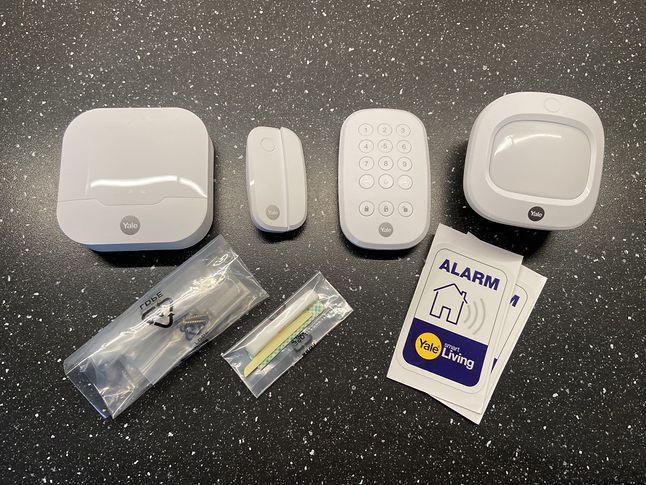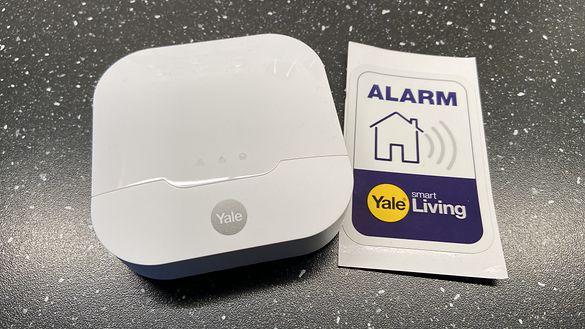Yale Sync Smart Home Alarm - we test the alarm from the Internet of Things
Alarm devices from the Yale brand have recently been introduced to our editorial office. The company, known primarily for its nearly 200-year-long tradition of building locks, entered a somewhat close market, the so-called intelligent alarm systems. Is it worth trusting this tradition also in such a modern edition? We decided to check it out.
The various devices included in the Yale Sync Smart Home Alarm system can of course be purchased separately as needed, but when it comes to starter kits, we have several packages to choose from. For testing, we received a basic package consisting of a base station (integrated with the siren), a motion sensor, a reed switch (door or window opening sensor) and a keyboard / remote control.
Of course, this is a very modest set, but for an undemanding user, it should be enough to secure a small apartment. An undoubted advantage of the system is that it can be expanded at any time - up to 40 devices. Investing in such an alarm system does not have to be associated with a large, one-off expense, and in the meantime, you can see if you like the system at a relatively low cost.
The cheapest starter package mentioned above can be found in online stores for around 700 zlotys. Each additional element is a separate expense. For example, the cost of an additional motion sensor is less than PLN 200, a door and window sensor - about PLN 120, a camera - from PLN 300 to PLN 600, and an electronic lock - about PLN 1,000.
Installation
Installation, as assumed by the manufacturer, should be very simple - we connect the base station to the power supply and an Ethernet cable to our home router, and then download the Yale Home application to the smartphone from the Play store or AppStore.
Why is there no WiFi? We have to remember that this is after all an alarm system and apparently the manufacturer decided to "more secure" network connectivity using the cable. The individual elements of the system, of course, already communicate wirelessly, but not in the WiFi network, but in the 868 MHz band.
Unfortunately, we must admit that the configuration left a slight distaste and is not as simple as we would like. The most unintuitive fact was that all devices in the starter package are already paired with each other, and yet the configurator in the application asks us to add all the devices and presents an empty list of existing sensors on a "good morning". Only after completing the configuration with an empty list it turns out that these devices "automagically" added to the system. You can waste a lot of time at this step, and simple information at the beginning would be enough.
When the devices "see" each other, it remains to mount them in their target places. Here you will find both mounting tapes and a set of screws with dowels. Physical installation should therefore not be too much of a problem.
It is only worth remembering that individual elements are not placed too far from the base station. The manufacturer ensures that the maximum range is 200 meters. In our tests, the system worked in an apartment with an area of about 60 square meters and there were no problems with coverage.
Device configuration
The mere addition of devices to the system is of course one thing, but it is also important to configure them properly - in accordance with our plans for their location in the house or apartment. In the Yale Sync alarm system, the sensor can function in four modes - "burglar", "bypass home", "home access" and "exit zone". If these names don't tell you anything at first, you are not alone. We also believe that the application was badly translated into Polish and unfortunately it is not the only example.


Returning to the configuration, however, the aforementioned operating modes of the sensor decide when it will be recognized as violated and the alarm will be triggered. The "bypass house" option allows you to exclude such a sensor when the alarm is only partially armed (eg armed mode on the ground floor, when there are household members on the first floor). The "home access" and "exit zone" options allow the sensors to be installed in the place where the control keyboard and / or exit door are located. The system is armed then with a delay of several seconds, so that we have time to leave the house. This delay time can be set separately for input and output.
Apart from the above, very simple configuration, the system does not offer any special "fountains". In particular, we will not configure several zones in the house that can be separately armed - here we only have the aforementioned "bypassing the house". The sensors can be named after you, and you can temporarily disable them (using the option translated as "bypass"), which also disables the tamper alarm that Yale Sync is also equipped with.
It is also worth mentioning the configuration of not only devices, but also the base station itself or the entire system. Users are the most important part of it. As for the numeric keypad for disarming and arming the alarm, we can add up to ten users here and give them personal PIN codes.
However, in order for our household members to also have access to the Yale Home application, we have to add them and their e-mail address again in a separate place - this may be a bit unintuitive, but we usually only do it once during the initial system configuration. Unfortunately, this is where the possibilities end, because we will not give specific users, for example, the right to disarm the alarm only on certain days or times. This could be a common scenario, e.g. when hiring domestic help and in more complex alarm systems this is often done.
How it's working?
The alarm can be fully or partially armed (the aforementioned mode, e.g. when a floor of the house remains unset). We do this either from the application or from the keyboard. There are no surprises here, everything works fine.
Can we be at ease when we leave? The Yale Home application will take care of this, in which we will receive push notifications about all events related to the alarm system - in particular, about the violation of one of the sensors. If we leave the house and forget to turn on the alarm, we can set notifications about this fact based on the geolocation of our phone. It is worse if another household member stays in the house and he will not be interested in arming the alarm.
Unfortunately, here too, the Polish language support is not so lame as in the application itself, but simply ... it is not there. The content of the notifications is in English and in a not very accessible form. However, you can more or less see what is going on and whether you need to return home quickly. By default, notifications also come to the e-mail address, also in English. Why this part of the system has not been translated into our native language remains a mystery.
And what happens when the home runs out of electricity or internet? Well, the alarm will still work. The base station has a battery, which will allow you to run a 100 dB siren quite loud for a small size. The device will also perform well in the event of a lack of internet connection - in the event of an alarm, the siren will sound, but of course we will not receive a notification about this fact. However, there is a good chance that the potential thief will be scared away.
Or maybe something more?
It is also worth mentioning that the Yale Sync alarm system can be integrated with popular voice assistants - Google and Alexa. It is then possible to ask the assistant, for example, if my alarm is armed or if the patio door is open, as well as to give commands to arm the alarm. Unfortunately, users living in the world of Apple devices will have to get away with the taste, because the Yale Home application does not work with Siri (another thing is that Siri has not learned Polish yet anyway).
Fans of smart homes and the Internet of Things will also be able to integrate the Yale Sync system with Philips Hue bulbs. However, this integration consists only in the fact that in the event of an alarm, we can alternately turn on and off the light in the house. By assumption, this is to draw the attention of neighbors or other outsiders that something is wrong with us - unless their attention has yet been drawn by the aforementioned siren, which really burns the rooms.
Unfortunately, this is where external integrations end, which is a pity, because it begs to be able to connect the system to other "smart homes". In the apartment where we tested the Yale Sync alarm, there is, for example, the Fibaro system operating in the Z-Wave technology. Unfortunately, the Z-Wave module, which can be purchased for the Yale system, works only with the locks of this manufacturer, not the entire alarm system. It is not possible to combine both solutions, which is a pity. Likewise, the lack of integration with HomeKit condemns us to the Yale Home application, which, as we have already written, is not the most intuitive.
However, we still have a number of Yale devices that we can expand the system with - starting from fire sensors and flood sensors through remote controls, an external siren and the aforementioned electronic locks, and ending with rotating cameras.
Time for a summary
What is the strength of the tested system? Certainly, at a good price, we get a basic protection, relatively easy to install and configure. The main function, i.e. arming the alarm and warning about violations, is performed very well by the system, exactly as we expected.
What is the weak point? The aforementioned simplicity, paradoxically. If we expect something even slightly more advanced than "turn on / off alarm", then we probably have to go to other manufacturers with "more alarm" traditions. The application is also a bit unsatisfied, especially its Polish translation. Editorial enthusiasts of smart homes were disappointed by the very limited possibilities of integration with other solutions, but probably as more advanced users we are not the target group in this case. So who is it?
ProsMinusOur Yale Sync Smart Home Alarm rating: 4/5We recommend the system to novice users who want to quickly and easily add alarm protection to their small apartment, garage, gazebo or cellar. We keep our fingers crossed that in the future the application will be more refined, and that the system will have a bit more configuration options - first of all, the division into zones (and not just "skipping the house") or various user permissions, including those based on hours and days of the week .








